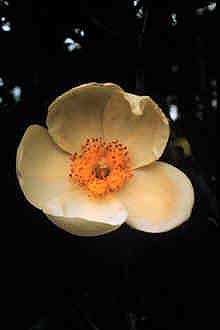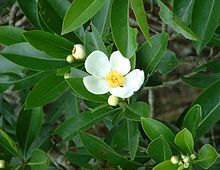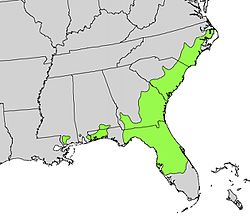Gordonia lasianthus
| Gordonia lasianthus | ||||||||||||
|---|---|---|---|---|---|---|---|---|---|---|---|---|

Gordonia lasianthus |
||||||||||||
| Systematics | ||||||||||||
|
||||||||||||
| Scientific name | ||||||||||||
| Gordonia lasianthus | ||||||||||||
| ( L. ) J. Ellis |
Gordonia lasianthus is a species of the genus Gordonia within the tea shrub family(Theaceae). It occurs in the southeastern United States. It is used in many ways.
description
Vegetative characteristics
Gordonia lasianthus is a slow growing, small to medium-sized evergreen tree or shrub . He reached heights of about 15-25 meters. The brownish to greyish bark is thick and furrowed to scaly.
The obovate to elliptical or lanceolate, leathery and short-stalked leaves are simple. The leaves are about 10-20 inches long and 2.5-4.5 inches wide. The leaf margin is whole to serrate, serrated, the tip is rounded to pointed and the leaf base is wedge-shaped. The nerve is pinnate with a lighter central vein raised underneath.
Generative characteristics
The relatively conspicuous, axillary, hermaphrodite, fragrant and white flowers are long-stalked, radial symmetry and five-fold with a double flower envelope. There are many stamens that are fused at the base in a fleshy, five-lobed ring. The hairy ovary is on top with a thick stylus with a lobed scar.
Loculicidal, egg-shaped and acuminate capsule fruits about 15-20 millimeters long are formed. The many light, flat and dark brown seeds are winged on one side and 10–15 millimeters long with wings.
ecology
The soft, light, cream-colored to carmine-red, finely grained wood is not very suitable for commercial use, although it could be used as pulpwood . When cases of old copies of the wood gives off a strong odor similar to a mixture of fresh oranges and pine resin. The bark of older trees takes on colors between medium gray and reddish brown. Dead specimens take on a shimmering sheen when they have been exposed to the sun for several years.
The shoots that drift from the stumps are severely bitten by deer.
development
The information in this section is based on measurements and observations made in the northern coastal plains of South Carolina.
Reproduction and Early Stages
Flowers and Fruits - The flowers are perfect. The formation of the flower buds occurs when young leaves are fully developed. The flower stalks elongate rapidly and the young bud slowly enlarges before the flower opens, initially at the top of the tree. The first flowers appear from the last week of June and the first week of July and persist until mid-August. The flowers stay open for a day or two and are pollinated by bumblebees , fringed-winged birds , flies and hummingbirds . After the second day, the petals and sepals fall off, leaving the ovary at the end of the stem.
Seed production and spread - As the ovaries develop, they gradually turn brown and five sutures develop. Ripe, open capsule fruits appear in September or October; All capsule fruits are open until mid-December. The seeds are shaken out of the capsules by the wind. The empty capsule fruits stay on the tree until they are shed together with the flower stalks from the end of December throughout the winter.
The scattering of seeds begins in October, peaks in December and continues until early March. The seeds of Gordonia lasianthus are light (265,000 to 333,000 per kilogram) and winged. Results of an investigation showed that about 99% of the seeds fall within a radius of twice the tree height around the parent tree, 94% within a radius of the tree height and 60% within a radius of half the tree height. During the two-year study, seed production fluctuated between 2,600 and 273,000 per hectare.
Development of the seedlings - The germination rate in sunlit Petri dishes is high: 70… 80% of the seeds germinate within 10 days. Similar germination rates were observed in a heated greenhouse at 13 ° C to 16 ° C, but this took up to 24 days. The germination is epigeic . Very few seedlings have been observed in the wild, and it appears that few would survive the first season. The germinating plants of G. lasianthus seem to need light, exposed areas for development. Older seedlings were only observed in places where they were disturbed , e.g. B. in fresh forest fire aisles.
The growth of the seedlings is slow at first. Field observations showed that the seedlings were 10 ... 15 cm high at the end of the third growing season, and only 30 ... 40 cm high at the end of the eighth growing season.
Vegetative Propagation - The vegetative propagation of annual saplings in a peat and sand medium under fog is preferred by gardeners. In nature, vegetative reproduction seems to be more common than that via seeds. Shoots from tree stumps can grow up to a meter tall in the first year after the tree is felled. These saplings appear to be an attractive food source for deer, as heavy grazing has been observed.
Numerous root saplings are produced after the tree is burned or when the root system has been mechanically destroyed by cutting and harrowing.
Development of the saplings via poles to mature trees
Growth and Yield - Early growth (up to 5-15 years of age) is relatively rapid. The increase in height in the first 15 years reached an average of 0.6 m / year, with 10-year-old trees reaching an average height of 6.5 meters. These rates are not achieved when the trees are grown from seeds. The data come from measurements on root- or stump-borne saplings. The early growth in thickness at breast height reaches about 0.4 cm / year, so that a ten-year-old tree reaches 5.1 ... 6.1 cm in diameter.
Root system - The root system of Gordonia lasianthus reflects the species' strong tendency towards vegetative reproduction. A number of specimens examined had a large primary sideways root from which secondary roots went in depth.
Competitive behavior - G. lasianthus is classified as shade tolerant. The species is competitive in bays and damp hollows where the canopy is relatively light. In general, it grows faster than the pines on the neighboring plateaus. However, if it becomes overgrown, older trees lose their typical conical shape and the top breaks off.
Causes of Damage - So far, only two causes of local damage (insects and pathogens ) have been identified. However, none of the pests were identified. Mud was found in the wound at the base of an older tree, but the tree itself appeared otherwise healthy. An unknown insect was responsible when in August all the leaves that had emerged late were eaten off except for the leaf veins. Otherwise, the sensitivity to fire should be mentioned, to which the thin bark and shallow roots may contribute. Deadwood is extremely susceptible to fungus; rotting sets in quickly.
Occurrence
Gordonia lasianthus is found in the southeastern United States. It thrives there in the lowlands of the Atlantic and Gulf coasts. It is found continuously between the coast of southern Virginia to the Appalachicola River in Florida . Isolated populations exist in Florida, the coastal counties of Alabama and Mississippi , in southern and southeastern Texas and in southern Louisiana . In South Carolina it is often found in the lower elevations of the coastal plains, but is restricted to special locations in the middle and higher elevations of these regions.
It thrives best on acidic, swampy soils of pine heather and bays
Climate in the distribution area
The climate in the range of Gordonia lasianthus is determined by mild winters and warm summers. Air temperature data from a weather atlas can be summarized as follows:
| Property | Northern extremum | Southern extremum |
|---|---|---|
| Temperature: | 16 ° C | 21 ° C |
| Daily mean temperature | 3 ° C | 11 ° C |
| Normal daily minimum; January | 10 ° C | 11 ° C |
| Normal daily maximum; July | 31 ° C | 32 ° C |
| Days with a maximum above 32 ° C | 20th | 120 |
| Days with a minimum below 0 ° C | 50 | 3 |
| Average of frost-free days | 230 | 320 |
The annual average precipitation in the range of Gordonia lasianthus in Florida is 1630 millimeters (in North Carolina at 1120 millimeters) and is fairly evenly distributed over the year. About 53% of the annual precipitation falls from June to October. During the year there are between 110 and 120 days with just one trace of precipitation.
Socialization in forests
Gordonia lasianthus is found in five forest communities within the Atlantic coastal plains. Bald cypress forests (Type 100 of the Society of American Foresters) are found in several of the Carolina Bays with stagnant water. G. lasianthus belongs to the species inventory together with upright bald cypress ( Taxodium distichum var. Nutans ), possibly because of the high water table; it becomes rarer at the better-ventilated edges. Here it grows together with frankincense pine ( Pinus taeda ) and Persea borbonia var. Borbonia in the tree layer as well as Lyonia lucida , Ilex glabra and stinging winds ( Smilax spec.) In the undergrowth.
Gordonia lasianthus is a subordinate, but not a permanent part of the frankincense pine forests (type 82). In the moderately high coastal plains of South Carolina, it is usually found with frankincense pine, water oak ( Quercus nigra ), sweetgum ( Liquidambar styraciflua ), American holly ( Ilex opaca ), Persea borbonia , swamp pine ( Pinus palustris ) and tulip tree ( Liriodendron tulipifera ) socialized. It only grows in the more humid areas of this type of forest.
Gordonia lasianthus is a subordinate part of the Atlantic cypress forests (type 97), together with Pinus serotina , Cyrilla racemiflora , Persea borbonia and Magnolia virginiana .
Pinus serotina forests (type 98) form the typical vegetation of humid depressions and some Carolina Bays in South Carolina. Gordonia lasianthus , Pinus serotina , Magnolia virginiana and Persea borbonia are the predominant tree species that rarely form a closed canopy. The thick shrub layer is composed of Lyonia lucida , Smilax species, Ilex glabra and Gordonia lasianthus .
Magnolia Tupelo Persea forests (type 104) are the "evergreen deciduous forests" of the lower coastal plains of North and South Carolina. Gordonia lasianthus is a subordinate component that grows in the tree layer together with Acer rubrum , Nyssa sylvatica var. Sylvatica , Magnolia virginiana and Quercus nigra .
Soils and topography
In North and South Carolina, Gordonia lasianthus appears to be highly specialized in certain soils, although the species is found on different soil types. It grows on Podsolen , Inceptisolen , Ultisolen and Histosolen and, to a lesser extent, on Entisolen and Mollisolen . Soil profiles of a site of Gordonia lasianthus in South Carolina are characterized by the following properties in different soil horizons :
- A1 - 0 to 25 cm: black or dark gray; Fine sand or loamy sand; very strong or extremely acidic,
- A2 - 25 to 38 cm: black or gray; Sand, loamy fine sand or sandy loam; very strong or extremely acidic (often no A2 horizon available),
- W - 38 to 51 (127) cm: gray or brown; Sand to sandy loam; very strongly acidic (often not available),
- C - (51) 127 to 175 cm: gray or brown; Sand, fine sand or loamy fine sand; strongly to very strongly acidic.
Gordonia lasianthus grows in flat forest areas or shallow hollows with little or no slope, slow water runoff, high permeability and little to very little ventilation. In South Carolina, soils, with the exception of organic soils, usually come from sandy coastal plains or the ocean. The water table is directly below or near the surface of the ground for 6 to 9 months a year.
In South Carolina's lower coastal plains, Gordonia lasianthus occurs in damp depressions or bays, typically in the Carolina Bays . In the higher areas of the coastal plains, the species is widespread in moist, flat forests on various types of soil.
Common names in other languages
Common English names are: loblolly-bay, holly-bay, gordonia, bay.
use
The attractive white flowers and glossy foliage make Gordonia lasianthus a suitable ornamental plant, but one that is not easy to cultivate. Gordonia lasianthus has long been used by landscape gardeners . Much of the research was initiated by gardeners interested in spreading Gordonia lasianthus . In the southeastern United States, Gordonia lasianthus is considered to be a frugal and hard tree, valued for its glossy dark green foliage and numerous white flowers.
The wood was used for paneling and the bark for tanning . If the bark is immersed in warm water, both the container and the water are colored bright crimson.
Because of its ability to grow in wet bogs and depressions, where the swamp pine does poorly, the forestry use of Gordonia lasianthus could be an alternative in some areas.
Recent laboratory tests on papermaking and data from the literature suggest that fiber recovery would give an acceptable yield (52%); the paper thickness (1.46 cm / g) was low and the strength acceptable. A laboratory test revealed a breaking length of 11,525 meters, a tensile stress of 10.2 kgf / 15 mm and a number of folds when using a 836 fold auditor of the Massachusetts Institute of Technology (1 kg). Although further testing is required, these attempts do not reveal any problems in the artisanal production of paper from the fibers of Gordonia lasianthus . Pulp mills in the lower coastal plains of South Carolina use the trees in their production.
literature
- Charles Sprague Sargent : Silva of North America. Volume 1, Houghton Mifflin Co., Boston, MA., 1891, pp. 41-44, t. 21, online at biodiversitylibrary.org.
- Gordonia and Gordonia lasianthus in the Flora of North America, Vol. 8.
- Gil Nelson: The Trees of Florida: A Reference and Field Guide. Second Edition, Pinaple Press, 2011, ISBN 978-1-561-64-474-2 , p. 394.
Web links
- Sheet at floridata (English) ( Memento of 28 April 2015, Internet Archive ).
Individual evidence
- ^ Charles A. Gresham, Donald J. Lipscomb: Selected Ecological Characteristics of Gordonia lasianthus in Coastal South Carolina . In: Bulletin of the Torrey Botanical Club . 112, No. 1, January-March 1985, pp. 53-58.
- ^ A b L. H. Bailey: Standard encyclopedia of horticulture , Volume 2. Macmillan, New York 1928, p. 1361.
- ↑ a b B. S. Wells: Plant communities of the Coastal Plain of North Carolina and their successional relations . In: Ecology . 9, 1928, pp. 230-242.
- ^ US Department of Commerce, Environmental Science Services Administration: Weather atlas of the United States , (reprinted 1975). Edition, Gale Research Co., Detroit, MI 1968, p. 262.
- ↑ FH Eyre (ed.): Forest cover types of the United States and Canada . Society of American Foresters, Washington, DC 1980, p. 148.
- ↑ a b B. W. Wells, SG Boyce: Carolina Bays: additional data on their origin and history . In: Journal of the Elisha Mitchell Society . 69, 1953, pp. 119-141 ..
- ^ BW Wells: The natural gardens of North Carolina . University of North Carolina Press, Chapel Hill 1932.
- ↑ Soil Survey Staff: Soil taxonomy: a basic system of soil classification for making and interpreting soil surveys (= US Department of Agriculture, Agriculture Handbook), Volume 436. US Department of Agriculture, Soil Conservation Service, Washington, DC. 1975, p. 754.
- ↑ ES Harrar: Hough's encyclopedia of American woods , Volume 4. Robert Speller and Sons, New York. 1964.
- ↑ LF Foreman: force pulping of southern hardwoods . In: Paper Mill News . 69, No. 4, 1946, p. 74.
- ^ LF Foreman, DD Niemeyer: Kraft pulping of southern hardwoods (= Monograph Series 4). Technical Association of the Pulp and Paper Industry, New York 1947.


